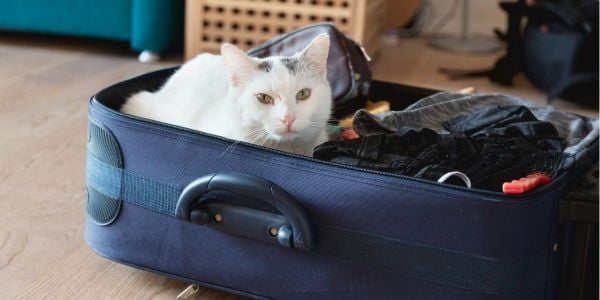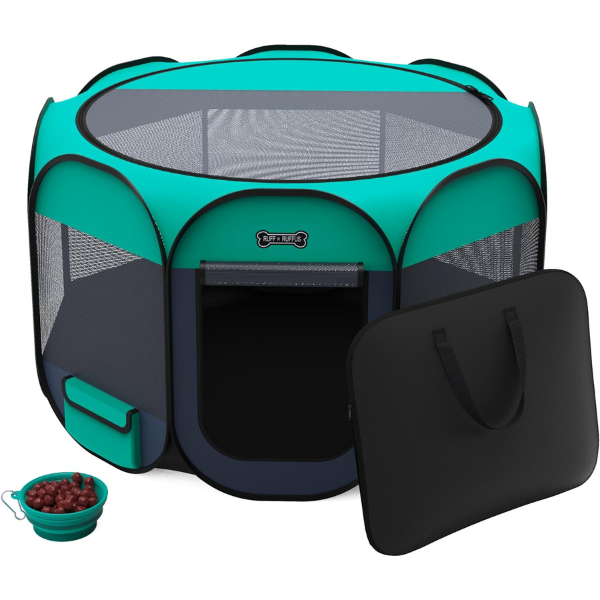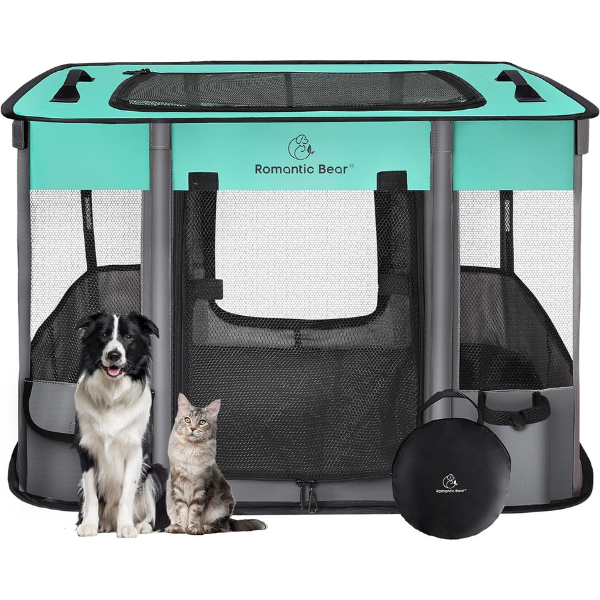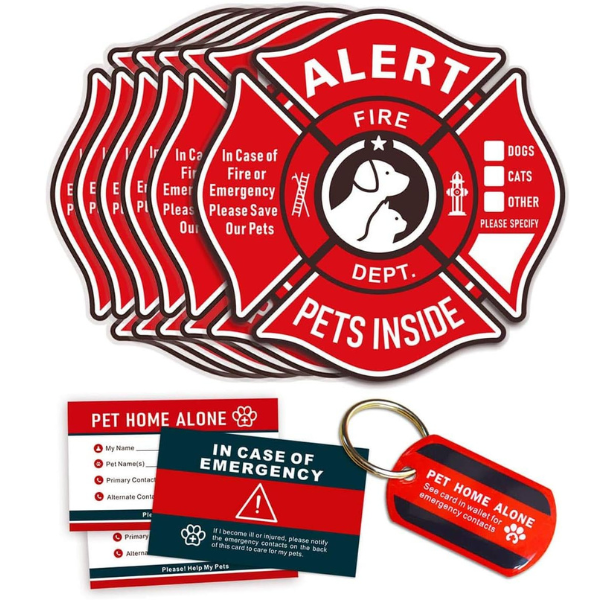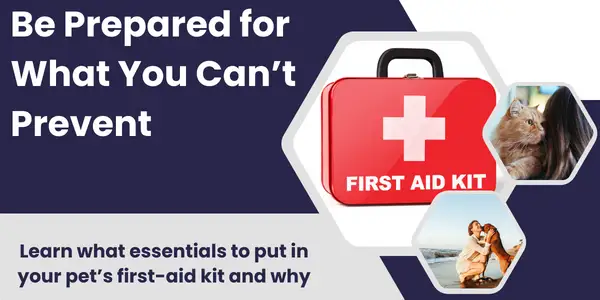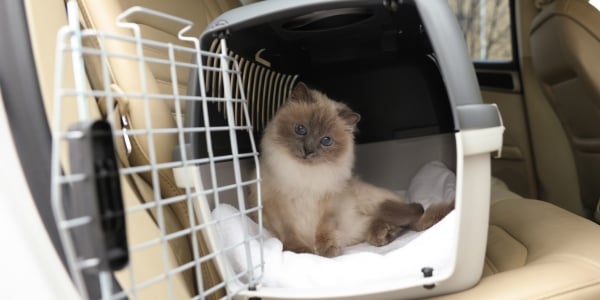
During the summer months and around the holidays, many of us head out on road trips and consider taking our feline family members along.
Summer is also a peak time for relocating across town or across the country.
The problem is that most cats don’t feel safe in the car. They may cry or yowl, hide in their carrier, and even soil due to fear. That means an unpleasant trip for them and you.
It is possible to help your cat feel more secure in the car. Some may even learn to love it. We’re going to walk you through the steps to desensitize your cat to being in the car.
We’ll also recommend travel items to bring in the car and for a hotel stay so that you both have a safe and comfortable trip.
Skip to section:
Getting Your Cat Ready for a Road Trip
Step 1: Get your kitty feeling comfortable in their carrier.
If they're going to ride in the car, like you, they’ll need to be safely “buckled up” to protect not just them but everyone in the car and on the road.
After all, unrestrained cats can be a distraction, interfering with your ability to steer or brake, and even becoming a dangerous projectile in the event of a crash or sudden stop.
What if your cat is wearing a harness and leash? If the car is moving, I still say keep them secure in a carrier. If you want to let them stretch their legs on the harness and leash while the car is stopped and windows are up, go for it. Just keep in mind that you’ve got to get them back in the carrier when you start moving again, and they may not love that.
It could be less stressful for everyone to stick with the carrier in the car and try the harness and leash INSIDE your hotel or destination. More on the dangers of letting your cat out of the car on their harness and leash later in the article.
So, your first step starts well before your trip. Spend some time training your cat to love their carrier – we have an article on that process – before the big travel day arrives.
Don't have a carrier for your cat yet? Check out our carrier recommendations, including carriers that are crash-test certified. If your cat is going to be spending a lot of long hours in the car, you may opt for a larger carrier than normal. We cover that, too. Just keep in mind you’ll want that carrier sooner rather than later, so you can use it during the pre-travel training.
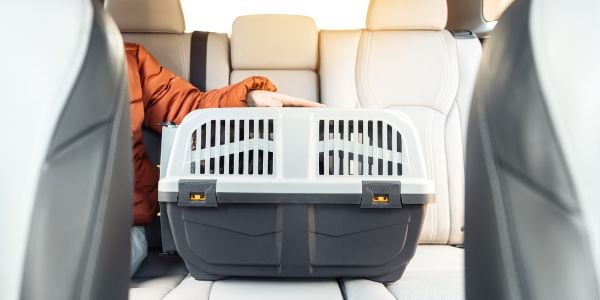
Step 2: Get your cat feeling comfortable in the car.
Now that your kitty feels better in their carrier, it’s time to help them feel comfortable in the car. Here are some steps to help you do that.
Pro Tip: Car acclimation is best done with two people … one to drive the car, the other to pet, praise, and treat kitty. It can be done with one person, too, but very carefully.
You’re going to do short sessions in the car – your cat dictates how long the sessions will be. The number of sessions depends on how quickly your cat gets comfortable. The main thing is that you don’t want to push your cat past their comfort zone. Your cat should always be calm.
You might be thinking that even if your cat is scared, leaving them in the car in spite of their fear will eventually show them they don’t have to be afraid. Nope! That’s not how cat brains work. Instead, think of it as starting at a really low intensity so your cat doesn’t have to be scared. As they’re ready, you slowly turn up the intensity.
If you turn it up too far and they get nervous, just end the session and lower the intensity for the next session.
Show them there’s no reason to be afraid because you’re not going to push them too far. And they’re getting good things through the entire process, so you’re actually turning a scary thing into a positive thing.
-
Take your cat out to the car in their carrier – covered on three sides with a towel or blanket for security.
-
With the car parked and not running and the doors and windows closed (weather permitting), sit in the back seat with your cat in their carrier. Partially open one of the carrier doors if you can do so without your cat trying to get out.
Then, make good things happen. Give treats (make sure it's a treat they love), pets, praise, and show them this is a positive experience. Do this for just a few minutes (or longer if your cat is really enjoying it). Then, take them inside and end with treats and love. You’ll continue these sessions, gradually making them longer as your cat is comfortable, until your cat seems nice and calm, spending time in the car while in their carrier.
-
Next, you’ll turn up the intensity a bit by starting the car. Make sure the radio is off or very low (cats find classical music calming). And repeat the previous step.
Spend a few minutes in the back seat making good things happen for your cat while the car is running. If the engine really scares them, keep it short — just 1 minute with some treats. Again, you can gradually increase the length of time your cat is in the car, getting good things while the engine is on.
-
Caution: If your car is parked in your garage, either open your garage door or move your car out of the garage. Carbon monoxide is very dangerous for both of you!
-
-
Once your kitty is doing well with the car on, it’s time to turn the intensity up again. Time for a short drive.
You need to be in the front seat now. If you have a second person who can sit in the back with your cat to give rewards, that’s great. They should either give treats through the grates of the carrier or unzip a tiny opening. You don’t want your cat getting loose when the car is running.
If you’re doing the session solo, place an interactive, treat/kibble-dispensing toy in their carrier with them (the Egg-Cersizer and the SlimCat are great choices). Or just drop some treats in the carrier and hide a few in their blanket. They’ll reward themselves while you drive.
Note: If they’re too nervous to eat treats, they’re probably not ready for this step. Back it up and spend more time on the previous steps.
- Now, buckle the carrier to the seat (the back seat is best, so your cat is less likely to be a distraction to you and so you don't have to worry about the passenger seat airbag injuring them in an accident or sudden stop). Start up the car and go for a short ride.
It may just be pulling out of the driveway in the first couple of sessions. That’s just fine. You’ll work up to longer drives. And your cat will learn that being in the car doesn’t mean going to the vet.
Never push these drives further than your cat is comfortable with. Also, be sure to drive calmly and go easy on the gas pedal and brakes.Since each cat and each situation are different, it could take anywhere from a few sessions to several months for a cat to feel calm during car travel.
If your cat suffers from travel anxiety or carsickness, learn how to deal with it here. >
Car Travel Logistics With Cats
Will a Cat Use a Litter Box In a Car?
Jumping right down to “business,” … depending on the duration of your travel adventures with kitty and where you’re winding up, you’re going to have to deal with litter box accommodations. This is the case both when you’re on the road and when you get to your hotel or destination.
Just because you give your cat access to a box doesn’t mean they’ll use it, especially if they’re nervous.
Cats don’t like to eliminate when they feel unsafe. They'll likely choose to do their business once you get to your destination. It’s nothing to worry about unless they go more than about 24 hours without peeing. At that point, call your vet and see what they suggest.
When I moved with my cats, and we had 8-hour days in the car, they held it all day and most of the night.
If they’re willing, you can help your cat take care of business on the road in a few different ways.
First, get them a good travel litter box. You’ll use the same litter they use at home, and (perhaps) even a litter attractant.
A good travel litter box will be large enough for your cat to fit in yet small enough to fit in their carrier. It will also be waterproof and sturdy. You can use a small plastic litter box or there are also disposable litter box options available.
We have travel litter box and large carrier recommendations here.
Set the travel box up in your home as an alternate option before your trip so your cat can get used to it. Don’t replace your regular boxes with the travel box, though. Have all options available.
If Your Carrier Can't Fit a Litter Box
Letting your cat out of a carrier to use a box placed in the car isn’t ideal. I actually rescued a kitten from the roadside once without a carrier. That kitten ended up inside my dashboard. So, if you think your cat can’t hide in dangerous places within the confines of your car, you’re wrong.
If your trip isn’t too long and their carrier isn’t large enough to fit a litter box, you can go with a larger litter box that they can use at the hotel or destination.
Note: If your cat uses the smaller travel litter box on the road, don’t consider replacing your larger boxes at home. Tiny boxes are not ideal and don’t fit your cat’s instinctual needs. They’re not a good long-term option. They’re the lesser of two evils when you’re traveling — the other evil being your cat peeing in the carrier.
Should You Let Your Cat Go Outside?
My vote is no unless you have a cat who is completely comfortable with travel, being in new places, and seeing and hearing strange people, pets, and sounds.
The first concern is that no harness is 100% escape-proof. If your cat gets scared, they can and will get out of that harness and take off.
Second, they’re going to be surrounded by newness — smells, sights, sounds, things you can’t control. Even if they don’t get scared, the idea that you’ll be able to get them to focus on peeing at that moment isn’t very likely. Cats don’t pee and poop on cue the way dogs can. It’s safer to keep them in the car.
What Do You Do With Your Cat When You Have to Go?
If the temperatures aren’t too hot or cold to leave your cat in the car, just leave them in their carrier and go about your business. Just make it quick!
Cover three sides of the carrier so they feel more secure and are less of a target for theft. Use a light cover (blanket) for warm days and a heavier cover for cooler days. Both should still allow for airflow.
It's usually safe between about 40–65 degrees F (4–18 degrees C), though every cat and every situation will be different, so use this as a rough guide.
Talk to your vet about more specific safe temperature ranges for your cat based their age, breed, and any chronic medical conditions they may have or medications they may be on. If the temperatures are outside of that range, you’re going to have to take some precautions when making your own pit stops that take you away from your car.
In some cases, it may be possible for you to bring your cat into the bathroom with you in their carrier.
Quick tips if you must leave your cat in the car
- Some cars now have pet mode, like Telsa, Chevrolet Bolt, Rivian, and other Form and BMW models.
Caution: If you decide to leave your engine running in a gas-powered car, be aware that car engines and air conditioner compressors can and do fail, leading to excessively hot temperatures building up in the car quickly. Similar malfunctions can happen in EV cars, too, and if the battery dies, the cooling system will shut off. - If leaving your car and running the A/C or heat isn’t possible or practical, pre-cool or pre-heat your car the best you can by running the system on high for several minutes before you get out. Then, be quick!
- Move their carrier from the back seat to the back floor. Since hot air rises, it should be a bit cooler on the floor. There are fans made for keeping pets cool in the car, but we really can't overstate this: pets should never be left in a closed car, even in the shade or with cooling devices. In this case, it's simply for a quick amount of time.
- Park in the most well-shaded spot you can find.
- Park with your front windshield facing the sun and put up a reflective windshield sun shade like this one.
- Cracking the windows doesn’t make a huge difference, but it also doesn’t hurt (so long as your cat is securely in their carrier and there’s no danger of someone reaching into your car and stealing them and your stuff).
- Make sure you leave your cat plenty of water.
- If it's cold outside, add a warm blanket or fleece to your cat's carrier for them to snuggle up. If it's sunny, move the carrier to a sunny spot in the car.
- Be as quick with your stop as possible. If it’s a food break, get it to go from a drive-thru and eat it in your car.

Where to Stay When Traveling With Your Cat
Road trips and long-distance moves with cats will often require hotel stays. But not all hotels, motels, or rentals are pet-friendly. And just because they say they’re “pet” friendly doesn’t mean they’re “cat” friendly. So, plan ahead. Call to confirm they take cats and reserve the room or rental in advance.
GoPetFriendly.com has a searchable database to help you find pet-friendly accommodations.Pro Tip: “Pet-friendly” means other pets likely stayed in that room recently! Not everyone uses flea and other parasite protection on their cats and dogs.
Make sure your cat is protected before heading out on the road! Learn more about safe and effective parasite prevention for your cat, and talk to your veterinarian.
What to Do With Your Cat in the Hotel or Rental
Once you’re out of the car, you’re faced with a question. Do you let your cat out in the hotel or rental to explore, or do you keep them confined? There’s a lot that goes into the answer. Here are some things to consider:
-
Is your cat relaxed in new places? Being in their carrier in the car is different than being in a completely new room with smells and places to hide.
-
Does your cat chew, climb, or otherwise destroy things? I couldn’t let my cat into a new space without putting cord protectors on every cord, or they’d be chewed in a matter of minutes.
-
Are there hiding places you can’t get to or unsafe spaces your cat can reach? The last thing you want is your cat stuck in the vents of a hotel or squeezing through that tiny hole in the wall behind the fridge in your rental. It happens.
-
Is it clean? Not to get gross, but you may not want your cat rolling around on a motel floor or getting under the bed.
-
Is it safe from toxins? There could be rodent traps or pest poison in the room that could be dangerous for your cat.
-
Is there any chance they’re going to pee on something? Yep, it happened to me on my road trip. My cat was stressed and peed all over the fabric carrier, and it soaked through to the bed. Talk about embarrassing. And there's sometimes an additional cleaning fee for mishaps like this.

Confinement for Safety
I like the idea of bringing along a much larger, collapsible pet pen for overnight use. They’re plenty big enough for a good-sized litter box and everything your cat needs. There’s even room to play. Just make sure you get one with a top, or your cat will jump right out.
If you want to let your cat out on a harness and leash or heavily supervised, you have the option. But you’ve got the pet pen as a backup, just in case you need it. You never know how a cat is going to react in a new space, especially when you’re sleeping or in the shower and they’re unsupervised. Here are a few great options:
Travel Considerations for Cats With Chronic Health Issues
Before striking out on the road for a long trip or moving with a cat who has a chronic medical condition or is on long-term medications — like diabetes, hyperthyroidism, chronic kidney disease, or heart disease — there are a few precautions you should take.
- Make sure your cat had a recent (ideally within the past month or so) exam with their vet. You’ll have more peace of mind knowing that their condition is as well managed as possible and that they’re as healthy as can be before hitting the road with them. Your vet will also have recommendations for making their trip as comfortable and safe as possible.
- Bring a copy of your cat’s medical records with you! This should include recent exam notes, laboratory test results, and medication/supplement names and dosages. Your vet can often print these out (with enough notice), and they may even subscribe to an app or other service that allows you to keep updated copies of such records with you always on your phone. This will make visiting another vet on the road much easier.
- Especially for cats with known chronic health concerns, it’s a good idea to know about a few vet hospitals along your route and in the area of your destination before you head out. See the vet locator tools listed in the next emergency section to start searching.
- If your cat is on a special prescription diet, like for their kidneys, make sure to stock up on it from your vet before leaving. It’s not always easy to get prescription diet refills when you’re away from home. You should take enough with you to last for the duration of your trip PLUS an additional (at least) 2 weeks.
- Similarly, be sure to stock up on your pet’s medications and supplements, as well as any supplies you need for them. This would include needles and a travel-sized sharps container (or larger needle container) for safely disposing of and storing used needles for diabetic cats, pills for blood pressure, overactive thyroid, and any other chronic medications. Again, you should take with you enough to last for the duration of your trip PLUS an additional (at least) 2 weeks.
- If your cat is diabetic and on insulin, don’t forget a cooler and ice packs to help keep it cool while in the car. You can also look into a cooler that plugs into your car’s cigarette lighter or USB, like these: Cooluli Mini, Wagan 14L, or the Wagan 24L (which could even store some of your food and drinks for the road).
Pro Tip: Depending on the type of insulin your cat is on, you may be able to get an insulin “pen” that may be more stable outside of the fridge and easier to administer to your cat. It's still advisable to use a cooling case for the pens. Talk to your vet to see if an insulin pen is an option for your cat — it isn’t for all cats, but if it is for yours, it could be a great travel (and even long-term) solution for you.
Emergencies on the Road With Your Cat
It’s a good idea to plan ahead and map out a few 24-hour Emergency Clinics on your route, just in case. Try this vet emergency locator.
Have your hometown veterinary clinic number handy, too. For less serious issues, call them first. They may be able to give you advice or let you know if it’s a true emergency.
Make sure you have a card in your wallet or attached to your cat’s carrier with your cat’s name, the number where you can be reached during travel, and an emergency contact who is not traveling with you. If your cat has medical issues, you should list those as well or the contact info for your veterinary clinic. If there’s an accident, your car is stolen, or something happens where you’re separated from your cat, emergency services will have options.
I just got this great set for myself (featured below). The keychain says “pet home alone,” with instructions to look in your wallet for a card with emergency contact info. It’s meant to notify emergency services if you’re in an emergency situation and someone needs to care for your pet at home. In this case, you’d just include a note on the card that you’re traveling with your cat in the car.
It’s also vital to ensure your cat is microchipped and the contact information is up-to-date (including a way you can be reached on the road).
First Aid on the Road
Consider putting together a pet first-aid kit for your car. Here's a shopping list of first-aid essentials. Look for the icon of a little car 🚗, as it's these products that are the most essential in a smaller, travel-sized first-aid kit.
We encourage you to leave a comment below if you’ve got any tricks, tips, or products you’ve used that made car travel with your cats easier. Best of luck on your travels or your move. Have fun and be safe!


